Project Management Report: Strategic Alignment, London Olympics 2012
VerifiedAdded on 2022/12/26
|17
|4296
|1
Report
AI Summary
This report provides a comprehensive analysis of the project management aspects of the London 2012 Olympics. It begins with an introduction to project management principles and then delves into the specifics of the Olympic project, including its goals, objectives, and stakeholder analysis. The report explores the strategic alignment of the project, examining how it integrated with public, environmental, and societal considerations, and also discusses the benefits management, governance structure, and financial aspects. The report further analyzes the decision-making processes involved, focusing on quality, cost, and deliverables. It identifies the key challenges faced and the innovative approaches used, including collaboration strategies. Finally, it provides a conclusion summarizing the key findings and references the sources used.

PROJECT MANAGEMENT
INTRODUCTION.....................................................................................................................................3
INTRODUCTION.....................................................................................................................................3
Paraphrase This Document
Need a fresh take? Get an instant paraphrase of this document with our AI Paraphraser
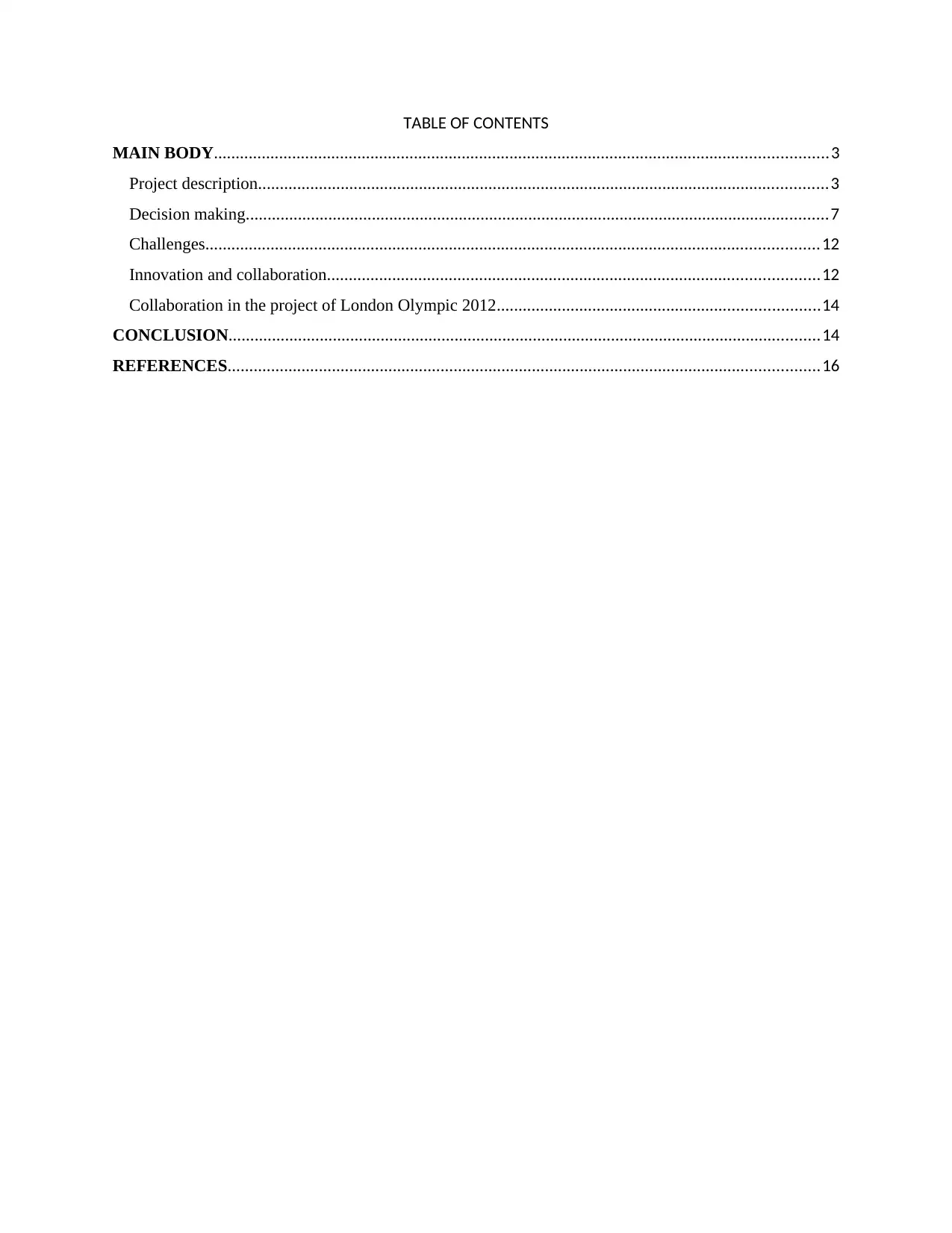
TABLE OF CONTENTS
MAIN BODY.............................................................................................................................................3
Project description...................................................................................................................................3
Decision making......................................................................................................................................7
Challenges.............................................................................................................................................12
Innovation and collaboration.................................................................................................................12
Collaboration in the project of London Olympic 2012..........................................................................14
CONCLUSION........................................................................................................................................14
REFERENCES........................................................................................................................................16
MAIN BODY.............................................................................................................................................3
Project description...................................................................................................................................3
Decision making......................................................................................................................................7
Challenges.............................................................................................................................................12
Innovation and collaboration.................................................................................................................12
Collaboration in the project of London Olympic 2012..........................................................................14
CONCLUSION........................................................................................................................................14
REFERENCES........................................................................................................................................16
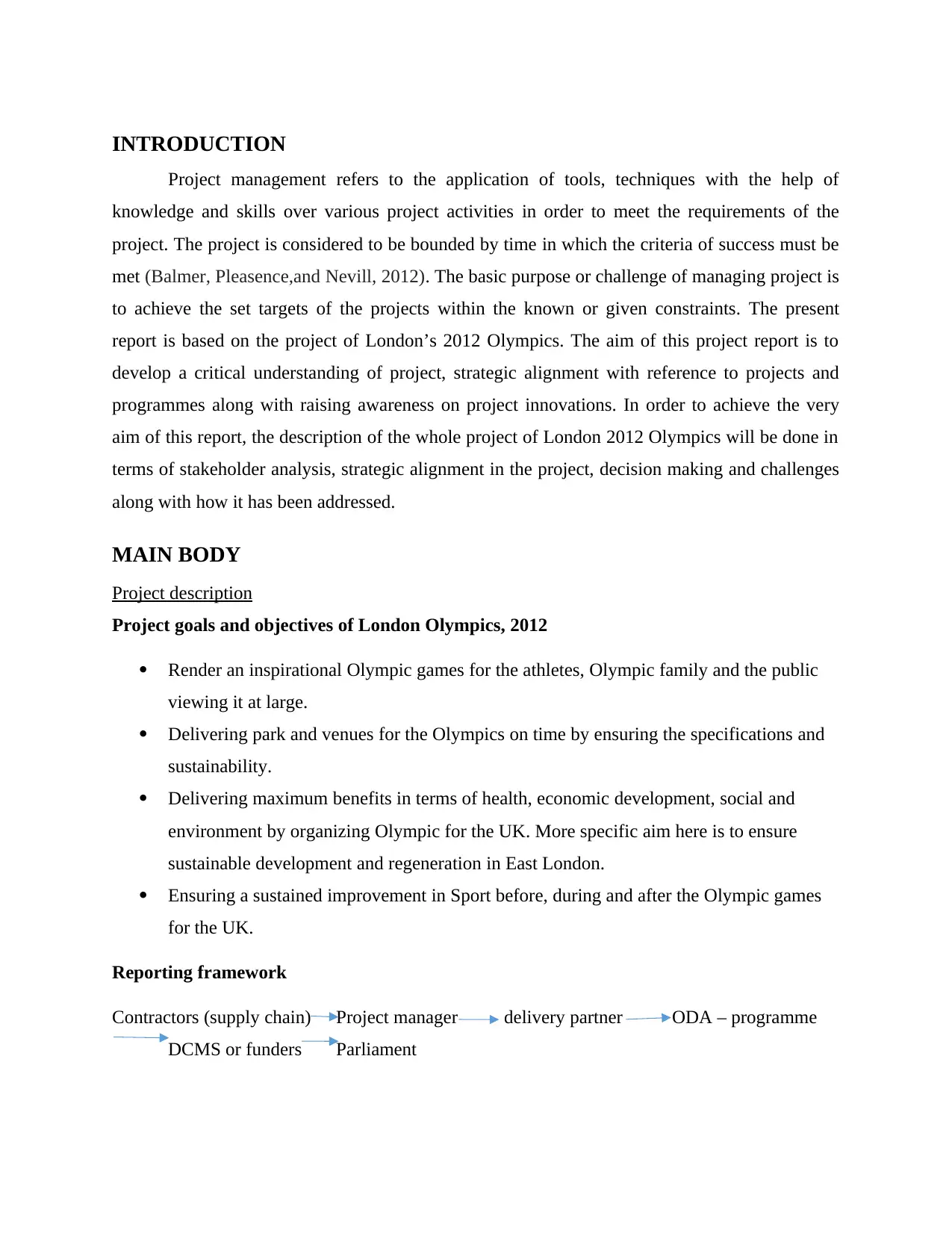
INTRODUCTION
Project management refers to the application of tools, techniques with the help of
knowledge and skills over various project activities in order to meet the requirements of the
project. The project is considered to be bounded by time in which the criteria of success must be
met (Balmer, Pleasence,and Nevill, 2012). The basic purpose or challenge of managing project is
to achieve the set targets of the projects within the known or given constraints. The present
report is based on the project of London’s 2012 Olympics. The aim of this project report is to
develop a critical understanding of project, strategic alignment with reference to projects and
programmes along with raising awareness on project innovations. In order to achieve the very
aim of this report, the description of the whole project of London 2012 Olympics will be done in
terms of stakeholder analysis, strategic alignment in the project, decision making and challenges
along with how it has been addressed.
MAIN BODY
Project description
Project goals and objectives of London Olympics, 2012
Render an inspirational Olympic games for the athletes, Olympic family and the public
viewing it at large.
Delivering park and venues for the Olympics on time by ensuring the specifications and
sustainability.
Delivering maximum benefits in terms of health, economic development, social and
environment by organizing Olympic for the UK. More specific aim here is to ensure
sustainable development and regeneration in East London.
Ensuring a sustained improvement in Sport before, during and after the Olympic games
for the UK.
Reporting framework
Contractors (supply chain) Project manager delivery partner ODA – programme
DCMS or funders Parliament
Project management refers to the application of tools, techniques with the help of
knowledge and skills over various project activities in order to meet the requirements of the
project. The project is considered to be bounded by time in which the criteria of success must be
met (Balmer, Pleasence,and Nevill, 2012). The basic purpose or challenge of managing project is
to achieve the set targets of the projects within the known or given constraints. The present
report is based on the project of London’s 2012 Olympics. The aim of this project report is to
develop a critical understanding of project, strategic alignment with reference to projects and
programmes along with raising awareness on project innovations. In order to achieve the very
aim of this report, the description of the whole project of London 2012 Olympics will be done in
terms of stakeholder analysis, strategic alignment in the project, decision making and challenges
along with how it has been addressed.
MAIN BODY
Project description
Project goals and objectives of London Olympics, 2012
Render an inspirational Olympic games for the athletes, Olympic family and the public
viewing it at large.
Delivering park and venues for the Olympics on time by ensuring the specifications and
sustainability.
Delivering maximum benefits in terms of health, economic development, social and
environment by organizing Olympic for the UK. More specific aim here is to ensure
sustainable development and regeneration in East London.
Ensuring a sustained improvement in Sport before, during and after the Olympic games
for the UK.
Reporting framework
Contractors (supply chain) Project manager delivery partner ODA – programme
DCMS or funders Parliament
⊘ This is a preview!⊘
Do you want full access?
Subscribe today to unlock all pages.

Trusted by 1+ million students worldwide
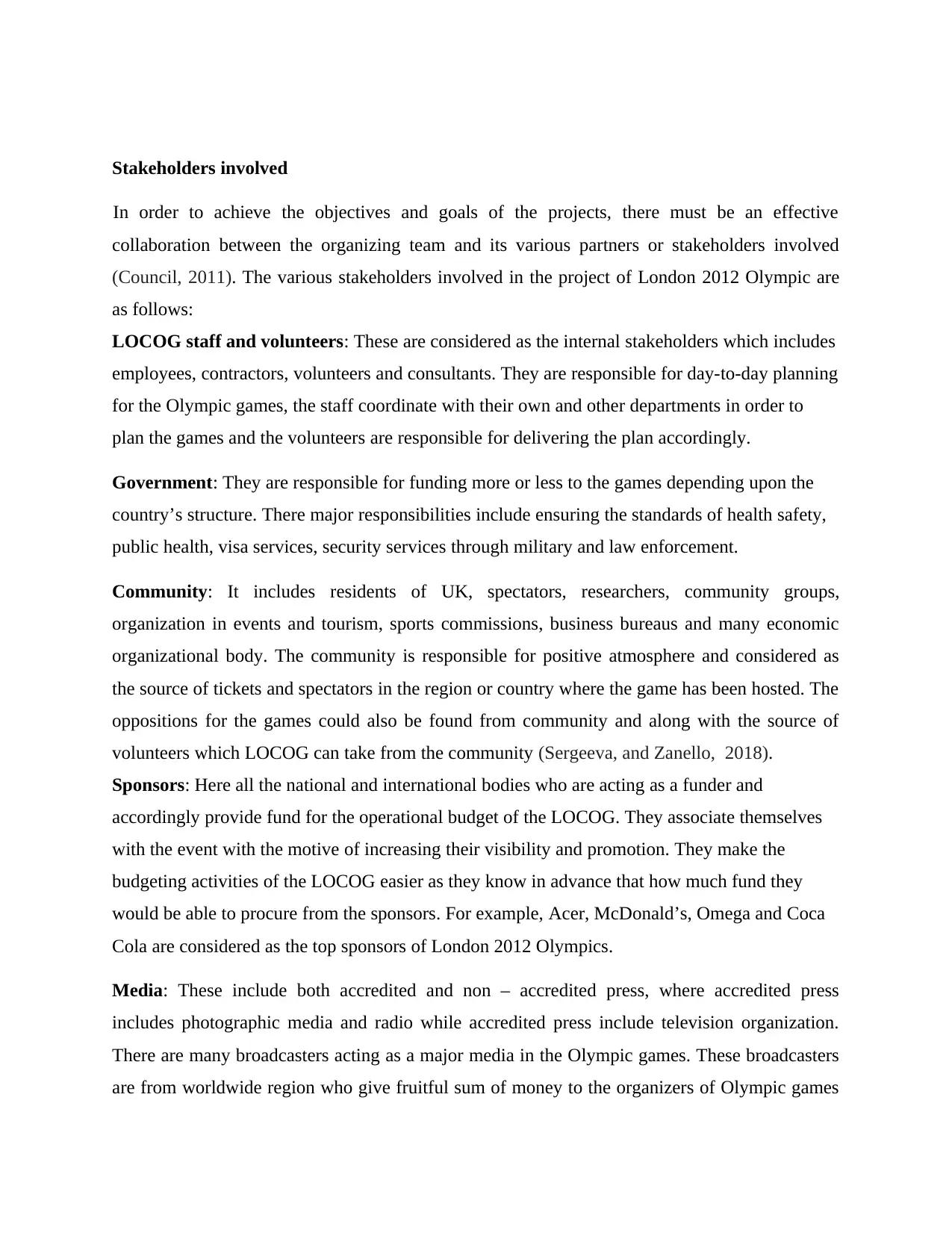
Stakeholders involved
In order to achieve the objectives and goals of the projects, there must be an effective
collaboration between the organizing team and its various partners or stakeholders involved
(Council, 2011). The various stakeholders involved in the project of London 2012 Olympic are
as follows:
LOCOG staff and volunteers: These are considered as the internal stakeholders which includes
employees, contractors, volunteers and consultants. They are responsible for day-to-day planning
for the Olympic games, the staff coordinate with their own and other departments in order to
plan the games and the volunteers are responsible for delivering the plan accordingly.
Government: They are responsible for funding more or less to the games depending upon the
country’s structure. There major responsibilities include ensuring the standards of health safety,
public health, visa services, security services through military and law enforcement.
Community: It includes residents of UK, spectators, researchers, community groups,
organization in events and tourism, sports commissions, business bureaus and many economic
organizational body. The community is responsible for positive atmosphere and considered as
the source of tickets and spectators in the region or country where the game has been hosted. The
oppositions for the games could also be found from community and along with the source of
volunteers which LOCOG can take from the community (Sergeeva, and Zanello, 2018).
Sponsors: Here all the national and international bodies who are acting as a funder and
accordingly provide fund for the operational budget of the LOCOG. They associate themselves
with the event with the motive of increasing their visibility and promotion. They make the
budgeting activities of the LOCOG easier as they know in advance that how much fund they
would be able to procure from the sponsors. For example, Acer, McDonald’s, Omega and Coca
Cola are considered as the top sponsors of London 2012 Olympics.
Media: These include both accredited and non – accredited press, where accredited press
includes photographic media and radio while accredited press include television organization.
There are many broadcasters acting as a major media in the Olympic games. These broadcasters
are from worldwide region who give fruitful sum of money to the organizers of Olympic games
In order to achieve the objectives and goals of the projects, there must be an effective
collaboration between the organizing team and its various partners or stakeholders involved
(Council, 2011). The various stakeholders involved in the project of London 2012 Olympic are
as follows:
LOCOG staff and volunteers: These are considered as the internal stakeholders which includes
employees, contractors, volunteers and consultants. They are responsible for day-to-day planning
for the Olympic games, the staff coordinate with their own and other departments in order to
plan the games and the volunteers are responsible for delivering the plan accordingly.
Government: They are responsible for funding more or less to the games depending upon the
country’s structure. There major responsibilities include ensuring the standards of health safety,
public health, visa services, security services through military and law enforcement.
Community: It includes residents of UK, spectators, researchers, community groups,
organization in events and tourism, sports commissions, business bureaus and many economic
organizational body. The community is responsible for positive atmosphere and considered as
the source of tickets and spectators in the region or country where the game has been hosted. The
oppositions for the games could also be found from community and along with the source of
volunteers which LOCOG can take from the community (Sergeeva, and Zanello, 2018).
Sponsors: Here all the national and international bodies who are acting as a funder and
accordingly provide fund for the operational budget of the LOCOG. They associate themselves
with the event with the motive of increasing their visibility and promotion. They make the
budgeting activities of the LOCOG easier as they know in advance that how much fund they
would be able to procure from the sponsors. For example, Acer, McDonald’s, Omega and Coca
Cola are considered as the top sponsors of London 2012 Olympics.
Media: These include both accredited and non – accredited press, where accredited press
includes photographic media and radio while accredited press include television organization.
There are many broadcasters acting as a major media in the Olympic games. These broadcasters
are from worldwide region who give fruitful sum of money to the organizers of Olympic games
Paraphrase This Document
Need a fresh take? Get an instant paraphrase of this document with our AI Paraphraser
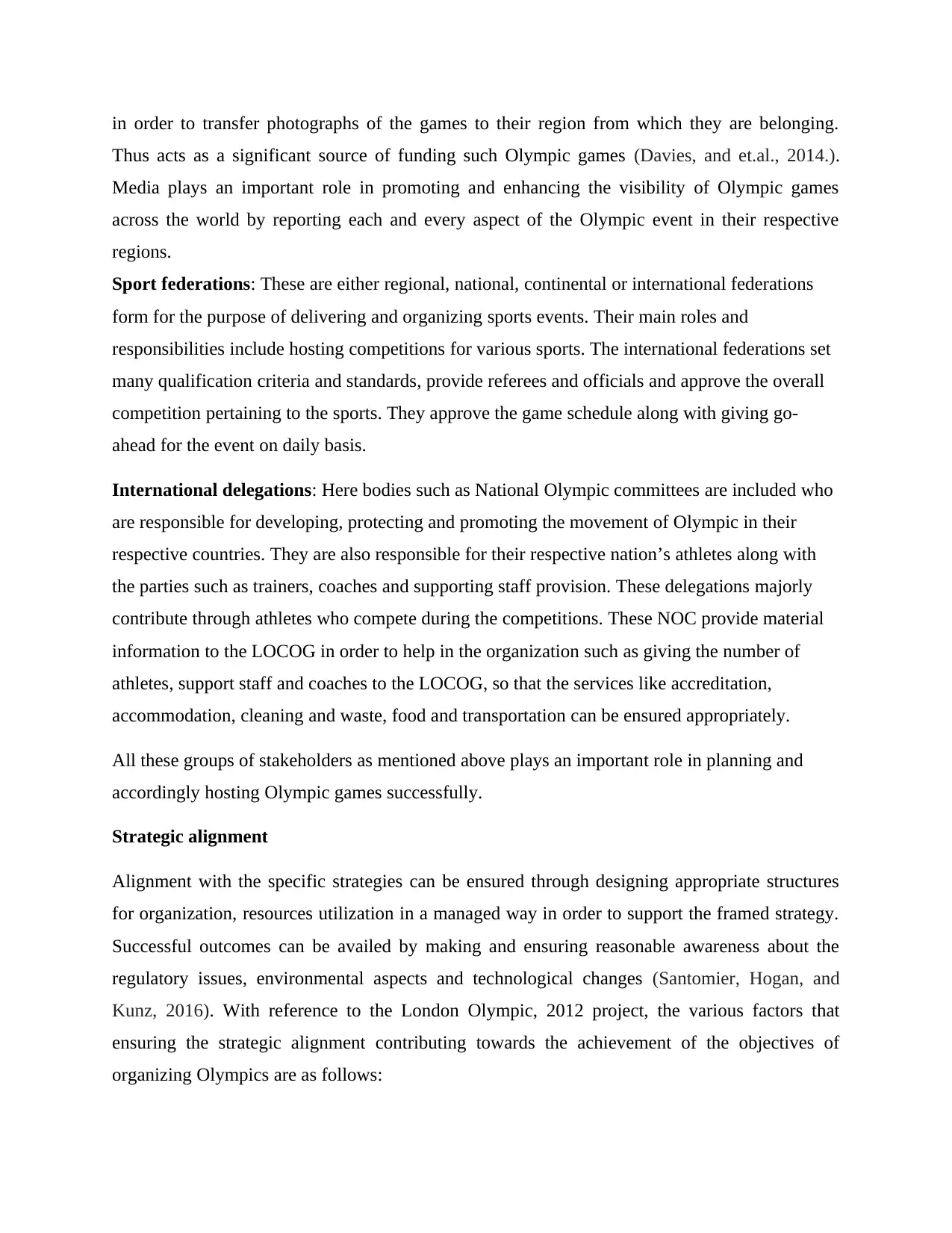
in order to transfer photographs of the games to their region from which they are belonging.
Thus acts as a significant source of funding such Olympic games (Davies, and et.al., 2014.).
Media plays an important role in promoting and enhancing the visibility of Olympic games
across the world by reporting each and every aspect of the Olympic event in their respective
regions.
Sport federations: These are either regional, national, continental or international federations
form for the purpose of delivering and organizing sports events. Their main roles and
responsibilities include hosting competitions for various sports. The international federations set
many qualification criteria and standards, provide referees and officials and approve the overall
competition pertaining to the sports. They approve the game schedule along with giving go-
ahead for the event on daily basis.
International delegations: Here bodies such as National Olympic committees are included who
are responsible for developing, protecting and promoting the movement of Olympic in their
respective countries. They are also responsible for their respective nation’s athletes along with
the parties such as trainers, coaches and supporting staff provision. These delegations majorly
contribute through athletes who compete during the competitions. These NOC provide material
information to the LOCOG in order to help in the organization such as giving the number of
athletes, support staff and coaches to the LOCOG, so that the services like accreditation,
accommodation, cleaning and waste, food and transportation can be ensured appropriately.
All these groups of stakeholders as mentioned above plays an important role in planning and
accordingly hosting Olympic games successfully.
Strategic alignment
Alignment with the specific strategies can be ensured through designing appropriate structures
for organization, resources utilization in a managed way in order to support the framed strategy.
Successful outcomes can be availed by making and ensuring reasonable awareness about the
regulatory issues, environmental aspects and technological changes (Santomier, Hogan, and
Kunz, 2016). With reference to the London Olympic, 2012 project, the various factors that
ensuring the strategic alignment contributing towards the achievement of the objectives of
organizing Olympics are as follows:
Thus acts as a significant source of funding such Olympic games (Davies, and et.al., 2014.).
Media plays an important role in promoting and enhancing the visibility of Olympic games
across the world by reporting each and every aspect of the Olympic event in their respective
regions.
Sport federations: These are either regional, national, continental or international federations
form for the purpose of delivering and organizing sports events. Their main roles and
responsibilities include hosting competitions for various sports. The international federations set
many qualification criteria and standards, provide referees and officials and approve the overall
competition pertaining to the sports. They approve the game schedule along with giving go-
ahead for the event on daily basis.
International delegations: Here bodies such as National Olympic committees are included who
are responsible for developing, protecting and promoting the movement of Olympic in their
respective countries. They are also responsible for their respective nation’s athletes along with
the parties such as trainers, coaches and supporting staff provision. These delegations majorly
contribute through athletes who compete during the competitions. These NOC provide material
information to the LOCOG in order to help in the organization such as giving the number of
athletes, support staff and coaches to the LOCOG, so that the services like accreditation,
accommodation, cleaning and waste, food and transportation can be ensured appropriately.
All these groups of stakeholders as mentioned above plays an important role in planning and
accordingly hosting Olympic games successfully.
Strategic alignment
Alignment with the specific strategies can be ensured through designing appropriate structures
for organization, resources utilization in a managed way in order to support the framed strategy.
Successful outcomes can be availed by making and ensuring reasonable awareness about the
regulatory issues, environmental aspects and technological changes (Santomier, Hogan, and
Kunz, 2016). With reference to the London Olympic, 2012 project, the various factors that
ensuring the strategic alignment contributing towards the achievement of the objectives of
organizing Olympics are as follows:
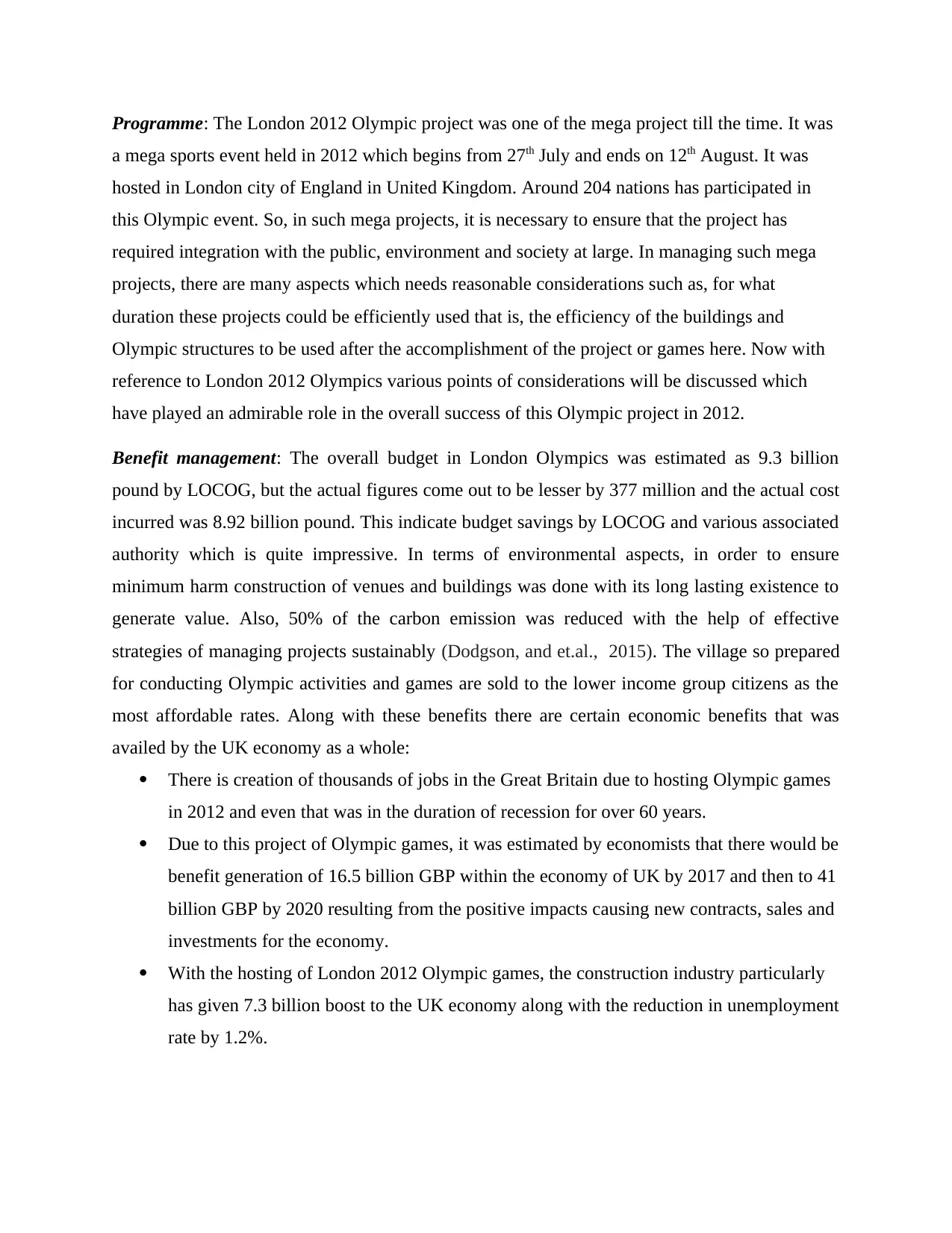
Programme: The London 2012 Olympic project was one of the mega project till the time. It was
a mega sports event held in 2012 which begins from 27th July and ends on 12th August. It was
hosted in London city of England in United Kingdom. Around 204 nations has participated in
this Olympic event. So, in such mega projects, it is necessary to ensure that the project has
required integration with the public, environment and society at large. In managing such mega
projects, there are many aspects which needs reasonable considerations such as, for what
duration these projects could be efficiently used that is, the efficiency of the buildings and
Olympic structures to be used after the accomplishment of the project or games here. Now with
reference to London 2012 Olympics various points of considerations will be discussed which
have played an admirable role in the overall success of this Olympic project in 2012.
Benefit management: The overall budget in London Olympics was estimated as 9.3 billion
pound by LOCOG, but the actual figures come out to be lesser by 377 million and the actual cost
incurred was 8.92 billion pound. This indicate budget savings by LOCOG and various associated
authority which is quite impressive. In terms of environmental aspects, in order to ensure
minimum harm construction of venues and buildings was done with its long lasting existence to
generate value. Also, 50% of the carbon emission was reduced with the help of effective
strategies of managing projects sustainably (Dodgson, and et.al., 2015). The village so prepared
for conducting Olympic activities and games are sold to the lower income group citizens as the
most affordable rates. Along with these benefits there are certain economic benefits that was
availed by the UK economy as a whole:
There is creation of thousands of jobs in the Great Britain due to hosting Olympic games
in 2012 and even that was in the duration of recession for over 60 years.
Due to this project of Olympic games, it was estimated by economists that there would be
benefit generation of 16.5 billion GBP within the economy of UK by 2017 and then to 41
billion GBP by 2020 resulting from the positive impacts causing new contracts, sales and
investments for the economy.
With the hosting of London 2012 Olympic games, the construction industry particularly
has given 7.3 billion boost to the UK economy along with the reduction in unemployment
rate by 1.2%.
a mega sports event held in 2012 which begins from 27th July and ends on 12th August. It was
hosted in London city of England in United Kingdom. Around 204 nations has participated in
this Olympic event. So, in such mega projects, it is necessary to ensure that the project has
required integration with the public, environment and society at large. In managing such mega
projects, there are many aspects which needs reasonable considerations such as, for what
duration these projects could be efficiently used that is, the efficiency of the buildings and
Olympic structures to be used after the accomplishment of the project or games here. Now with
reference to London 2012 Olympics various points of considerations will be discussed which
have played an admirable role in the overall success of this Olympic project in 2012.
Benefit management: The overall budget in London Olympics was estimated as 9.3 billion
pound by LOCOG, but the actual figures come out to be lesser by 377 million and the actual cost
incurred was 8.92 billion pound. This indicate budget savings by LOCOG and various associated
authority which is quite impressive. In terms of environmental aspects, in order to ensure
minimum harm construction of venues and buildings was done with its long lasting existence to
generate value. Also, 50% of the carbon emission was reduced with the help of effective
strategies of managing projects sustainably (Dodgson, and et.al., 2015). The village so prepared
for conducting Olympic activities and games are sold to the lower income group citizens as the
most affordable rates. Along with these benefits there are certain economic benefits that was
availed by the UK economy as a whole:
There is creation of thousands of jobs in the Great Britain due to hosting Olympic games
in 2012 and even that was in the duration of recession for over 60 years.
Due to this project of Olympic games, it was estimated by economists that there would be
benefit generation of 16.5 billion GBP within the economy of UK by 2017 and then to 41
billion GBP by 2020 resulting from the positive impacts causing new contracts, sales and
investments for the economy.
With the hosting of London 2012 Olympic games, the construction industry particularly
has given 7.3 billion boost to the UK economy along with the reduction in unemployment
rate by 1.2%.
⊘ This is a preview!⊘
Do you want full access?
Subscribe today to unlock all pages.

Trusted by 1+ million students worldwide
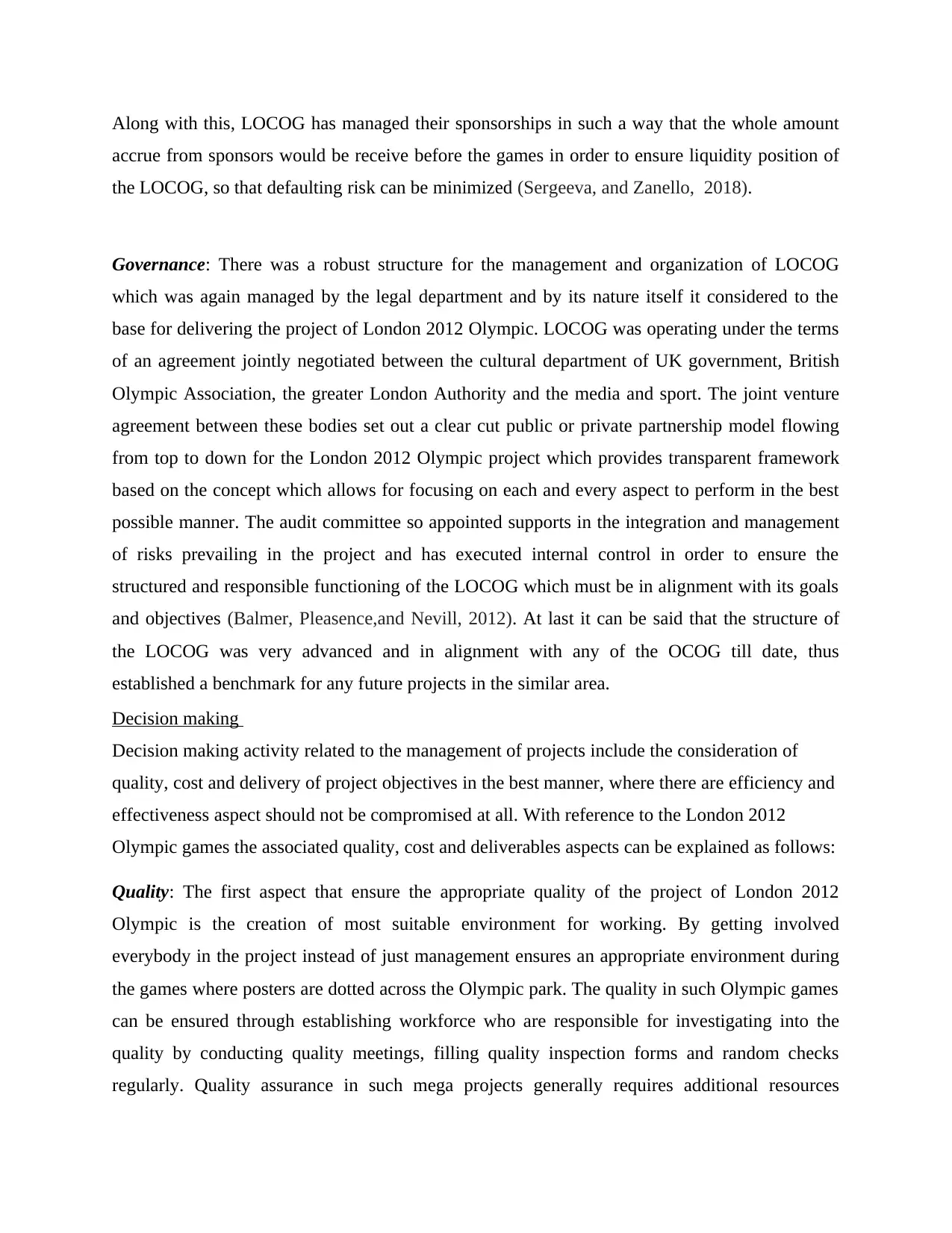
Along with this, LOCOG has managed their sponsorships in such a way that the whole amount
accrue from sponsors would be receive before the games in order to ensure liquidity position of
the LOCOG, so that defaulting risk can be minimized (Sergeeva, and Zanello, 2018).
Governance: There was a robust structure for the management and organization of LOCOG
which was again managed by the legal department and by its nature itself it considered to the
base for delivering the project of London 2012 Olympic. LOCOG was operating under the terms
of an agreement jointly negotiated between the cultural department of UK government, British
Olympic Association, the greater London Authority and the media and sport. The joint venture
agreement between these bodies set out a clear cut public or private partnership model flowing
from top to down for the London 2012 Olympic project which provides transparent framework
based on the concept which allows for focusing on each and every aspect to perform in the best
possible manner. The audit committee so appointed supports in the integration and management
of risks prevailing in the project and has executed internal control in order to ensure the
structured and responsible functioning of the LOCOG which must be in alignment with its goals
and objectives (Balmer, Pleasence,and Nevill, 2012). At last it can be said that the structure of
the LOCOG was very advanced and in alignment with any of the OCOG till date, thus
established a benchmark for any future projects in the similar area.
Decision making
Decision making activity related to the management of projects include the consideration of
quality, cost and delivery of project objectives in the best manner, where there are efficiency and
effectiveness aspect should not be compromised at all. With reference to the London 2012
Olympic games the associated quality, cost and deliverables aspects can be explained as follows:
Quality: The first aspect that ensure the appropriate quality of the project of London 2012
Olympic is the creation of most suitable environment for working. By getting involved
everybody in the project instead of just management ensures an appropriate environment during
the games where posters are dotted across the Olympic park. The quality in such Olympic games
can be ensured through establishing workforce who are responsible for investigating into the
quality by conducting quality meetings, filling quality inspection forms and random checks
regularly. Quality assurance in such mega projects generally requires additional resources
accrue from sponsors would be receive before the games in order to ensure liquidity position of
the LOCOG, so that defaulting risk can be minimized (Sergeeva, and Zanello, 2018).
Governance: There was a robust structure for the management and organization of LOCOG
which was again managed by the legal department and by its nature itself it considered to the
base for delivering the project of London 2012 Olympic. LOCOG was operating under the terms
of an agreement jointly negotiated between the cultural department of UK government, British
Olympic Association, the greater London Authority and the media and sport. The joint venture
agreement between these bodies set out a clear cut public or private partnership model flowing
from top to down for the London 2012 Olympic project which provides transparent framework
based on the concept which allows for focusing on each and every aspect to perform in the best
possible manner. The audit committee so appointed supports in the integration and management
of risks prevailing in the project and has executed internal control in order to ensure the
structured and responsible functioning of the LOCOG which must be in alignment with its goals
and objectives (Balmer, Pleasence,and Nevill, 2012). At last it can be said that the structure of
the LOCOG was very advanced and in alignment with any of the OCOG till date, thus
established a benchmark for any future projects in the similar area.
Decision making
Decision making activity related to the management of projects include the consideration of
quality, cost and delivery of project objectives in the best manner, where there are efficiency and
effectiveness aspect should not be compromised at all. With reference to the London 2012
Olympic games the associated quality, cost and deliverables aspects can be explained as follows:
Quality: The first aspect that ensure the appropriate quality of the project of London 2012
Olympic is the creation of most suitable environment for working. By getting involved
everybody in the project instead of just management ensures an appropriate environment during
the games where posters are dotted across the Olympic park. The quality in such Olympic games
can be ensured through establishing workforce who are responsible for investigating into the
quality by conducting quality meetings, filling quality inspection forms and random checks
regularly. Quality assurance in such mega projects generally requires additional resources
Paraphrase This Document
Need a fresh take? Get an instant paraphrase of this document with our AI Paraphraser
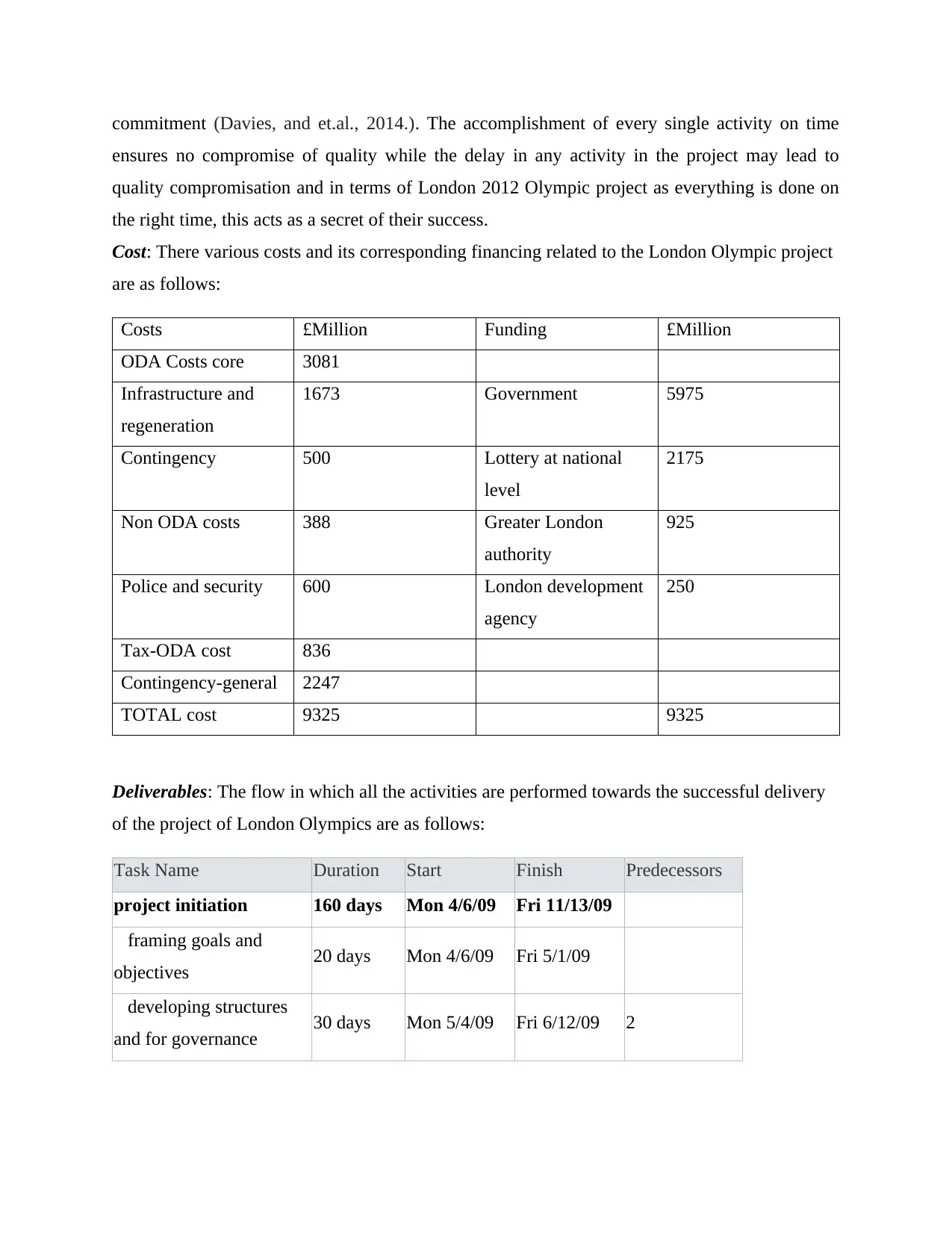
commitment (Davies, and et.al., 2014.). The accomplishment of every single activity on time
ensures no compromise of quality while the delay in any activity in the project may lead to
quality compromisation and in terms of London 2012 Olympic project as everything is done on
the right time, this acts as a secret of their success.
Cost: There various costs and its corresponding financing related to the London Olympic project
are as follows:
Costs £Million Funding £Million
ODA Costs core 3081
Infrastructure and
regeneration
1673 Government 5975
Contingency 500 Lottery at national
level
2175
Non ODA costs 388 Greater London
authority
925
Police and security 600 London development
agency
250
Tax-ODA cost 836
Contingency-general 2247
TOTAL cost 9325 9325
Deliverables: The flow in which all the activities are performed towards the successful delivery
of the project of London Olympics are as follows:
Task Name Duration Start Finish Predecessors
project initiation 160 days Mon 4/6/09 Fri 11/13/09
framing goals and
objectives 20 days Mon 4/6/09 Fri 5/1/09
developing structures
and for governance 30 days Mon 5/4/09 Fri 6/12/09 2
ensures no compromise of quality while the delay in any activity in the project may lead to
quality compromisation and in terms of London 2012 Olympic project as everything is done on
the right time, this acts as a secret of their success.
Cost: There various costs and its corresponding financing related to the London Olympic project
are as follows:
Costs £Million Funding £Million
ODA Costs core 3081
Infrastructure and
regeneration
1673 Government 5975
Contingency 500 Lottery at national
level
2175
Non ODA costs 388 Greater London
authority
925
Police and security 600 London development
agency
250
Tax-ODA cost 836
Contingency-general 2247
TOTAL cost 9325 9325
Deliverables: The flow in which all the activities are performed towards the successful delivery
of the project of London Olympics are as follows:
Task Name Duration Start Finish Predecessors
project initiation 160 days Mon 4/6/09 Fri 11/13/09
framing goals and
objectives 20 days Mon 4/6/09 Fri 5/1/09
developing structures
and for governance 30 days Mon 5/4/09 Fri 6/12/09 2
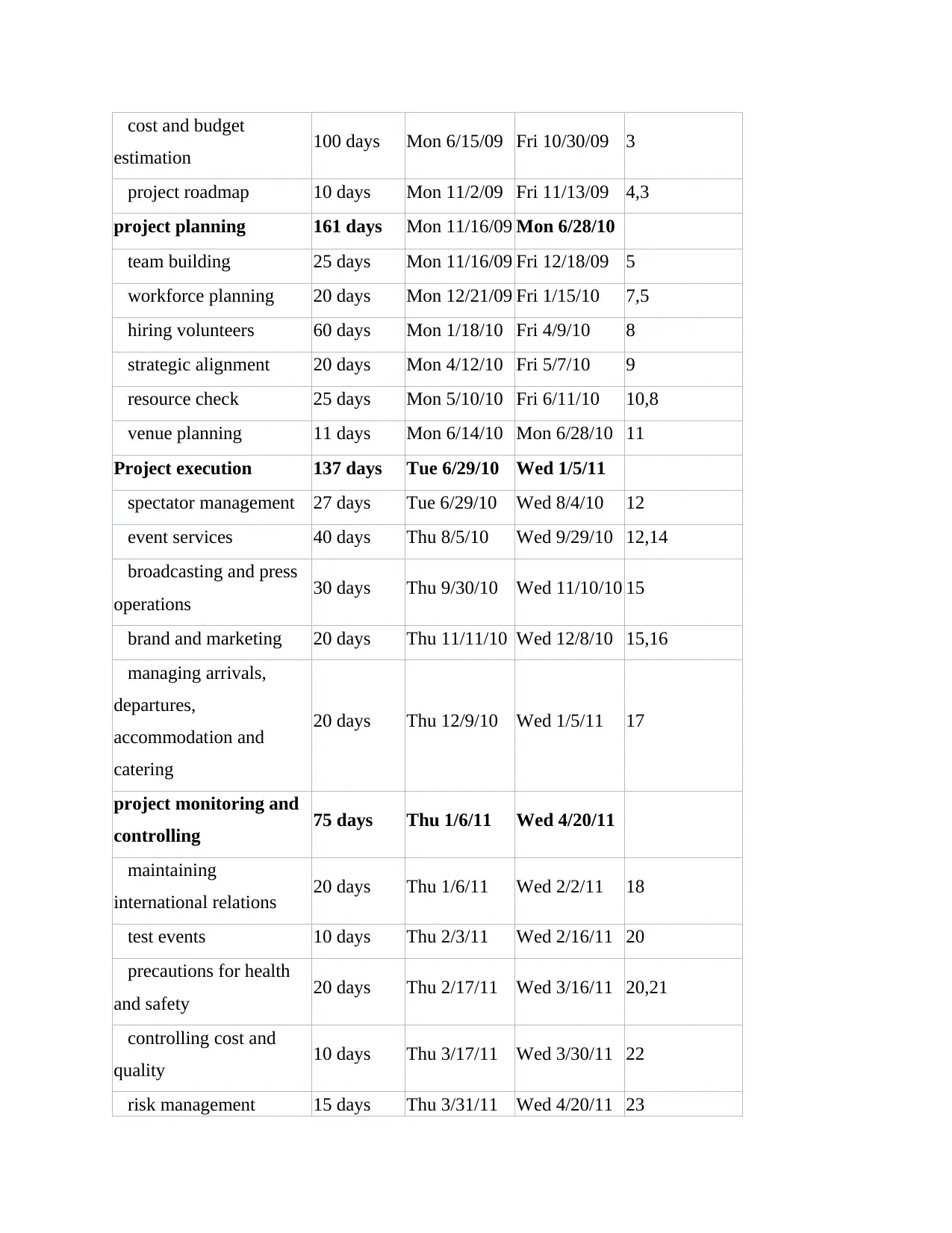
cost and budget
estimation 100 days Mon 6/15/09 Fri 10/30/09 3
project roadmap 10 days Mon 11/2/09 Fri 11/13/09 4,3
project planning 161 days Mon 11/16/09 Mon 6/28/10
team building 25 days Mon 11/16/09 Fri 12/18/09 5
workforce planning 20 days Mon 12/21/09 Fri 1/15/10 7,5
hiring volunteers 60 days Mon 1/18/10 Fri 4/9/10 8
strategic alignment 20 days Mon 4/12/10 Fri 5/7/10 9
resource check 25 days Mon 5/10/10 Fri 6/11/10 10,8
venue planning 11 days Mon 6/14/10 Mon 6/28/10 11
Project execution 137 days Tue 6/29/10 Wed 1/5/11
spectator management 27 days Tue 6/29/10 Wed 8/4/10 12
event services 40 days Thu 8/5/10 Wed 9/29/10 12,14
broadcasting and press
operations 30 days Thu 9/30/10 Wed 11/10/10 15
brand and marketing 20 days Thu 11/11/10 Wed 12/8/10 15,16
managing arrivals,
departures,
accommodation and
catering
20 days Thu 12/9/10 Wed 1/5/11 17
project monitoring and
controlling 75 days Thu 1/6/11 Wed 4/20/11
maintaining
international relations 20 days Thu 1/6/11 Wed 2/2/11 18
test events 10 days Thu 2/3/11 Wed 2/16/11 20
precautions for health
and safety 20 days Thu 2/17/11 Wed 3/16/11 20,21
controlling cost and
quality 10 days Thu 3/17/11 Wed 3/30/11 22
risk management 15 days Thu 3/31/11 Wed 4/20/11 23
estimation 100 days Mon 6/15/09 Fri 10/30/09 3
project roadmap 10 days Mon 11/2/09 Fri 11/13/09 4,3
project planning 161 days Mon 11/16/09 Mon 6/28/10
team building 25 days Mon 11/16/09 Fri 12/18/09 5
workforce planning 20 days Mon 12/21/09 Fri 1/15/10 7,5
hiring volunteers 60 days Mon 1/18/10 Fri 4/9/10 8
strategic alignment 20 days Mon 4/12/10 Fri 5/7/10 9
resource check 25 days Mon 5/10/10 Fri 6/11/10 10,8
venue planning 11 days Mon 6/14/10 Mon 6/28/10 11
Project execution 137 days Tue 6/29/10 Wed 1/5/11
spectator management 27 days Tue 6/29/10 Wed 8/4/10 12
event services 40 days Thu 8/5/10 Wed 9/29/10 12,14
broadcasting and press
operations 30 days Thu 9/30/10 Wed 11/10/10 15
brand and marketing 20 days Thu 11/11/10 Wed 12/8/10 15,16
managing arrivals,
departures,
accommodation and
catering
20 days Thu 12/9/10 Wed 1/5/11 17
project monitoring and
controlling 75 days Thu 1/6/11 Wed 4/20/11
maintaining
international relations 20 days Thu 1/6/11 Wed 2/2/11 18
test events 10 days Thu 2/3/11 Wed 2/16/11 20
precautions for health
and safety 20 days Thu 2/17/11 Wed 3/16/11 20,21
controlling cost and
quality 10 days Thu 3/17/11 Wed 3/30/11 22
risk management 15 days Thu 3/31/11 Wed 4/20/11 23
⊘ This is a preview!⊘
Do you want full access?
Subscribe today to unlock all pages.

Trusted by 1+ million students worldwide
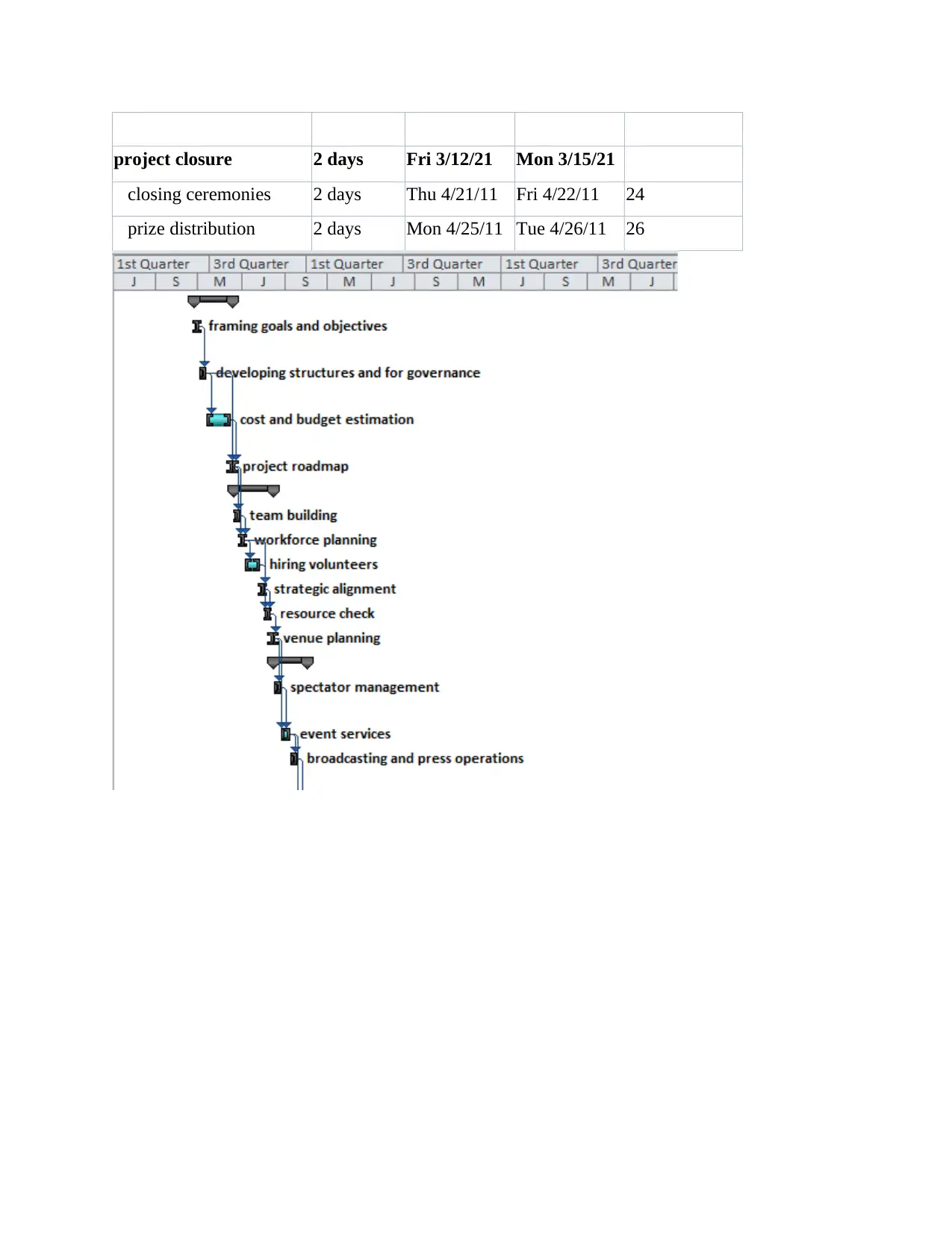
project closure 2 days Fri 3/12/21 Mon 3/15/21
closing ceremonies 2 days Thu 4/21/11 Fri 4/22/11 24
prize distribution 2 days Mon 4/25/11 Tue 4/26/11 26
closing ceremonies 2 days Thu 4/21/11 Fri 4/22/11 24
prize distribution 2 days Mon 4/25/11 Tue 4/26/11 26
Paraphrase This Document
Need a fresh take? Get an instant paraphrase of this document with our AI Paraphraser
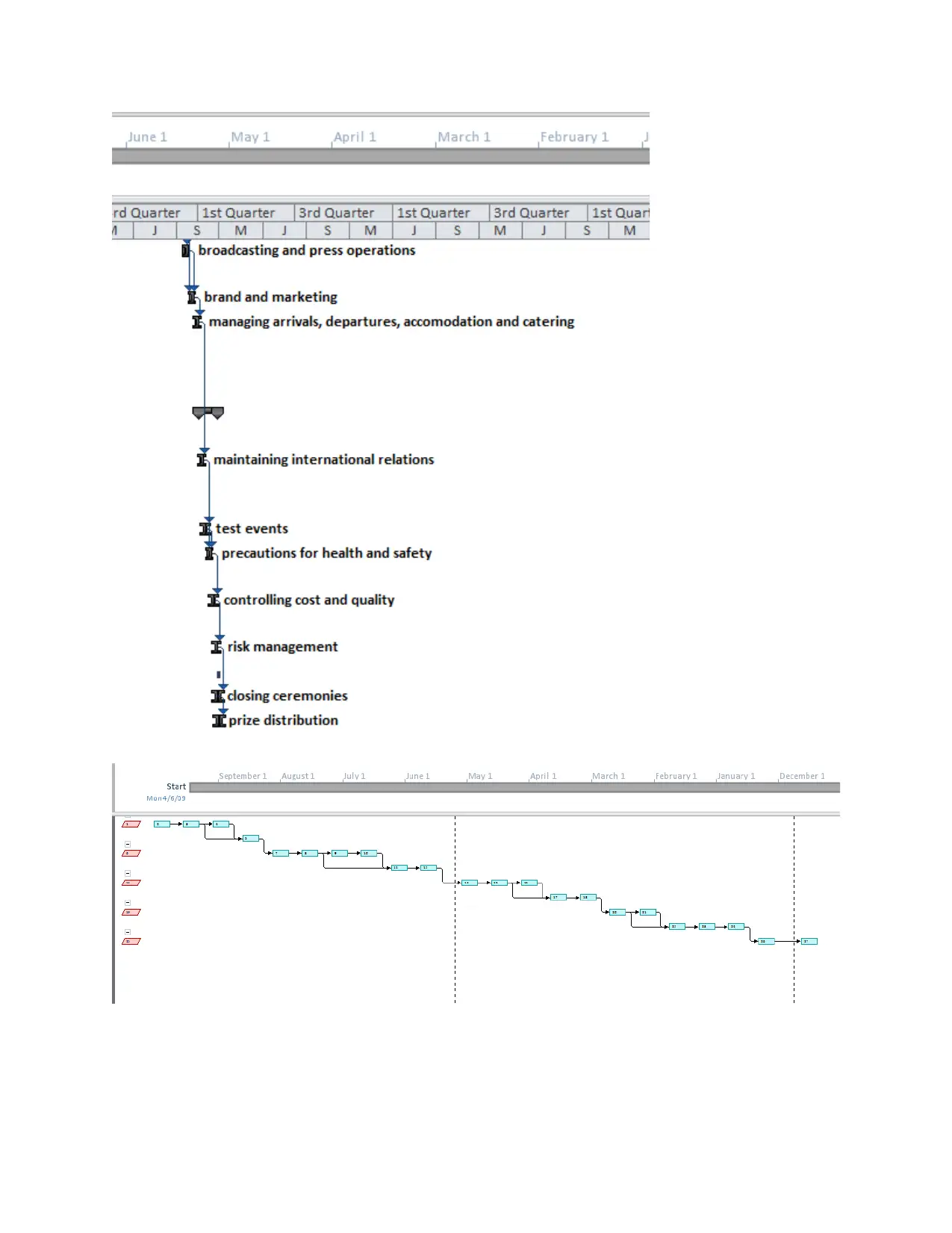
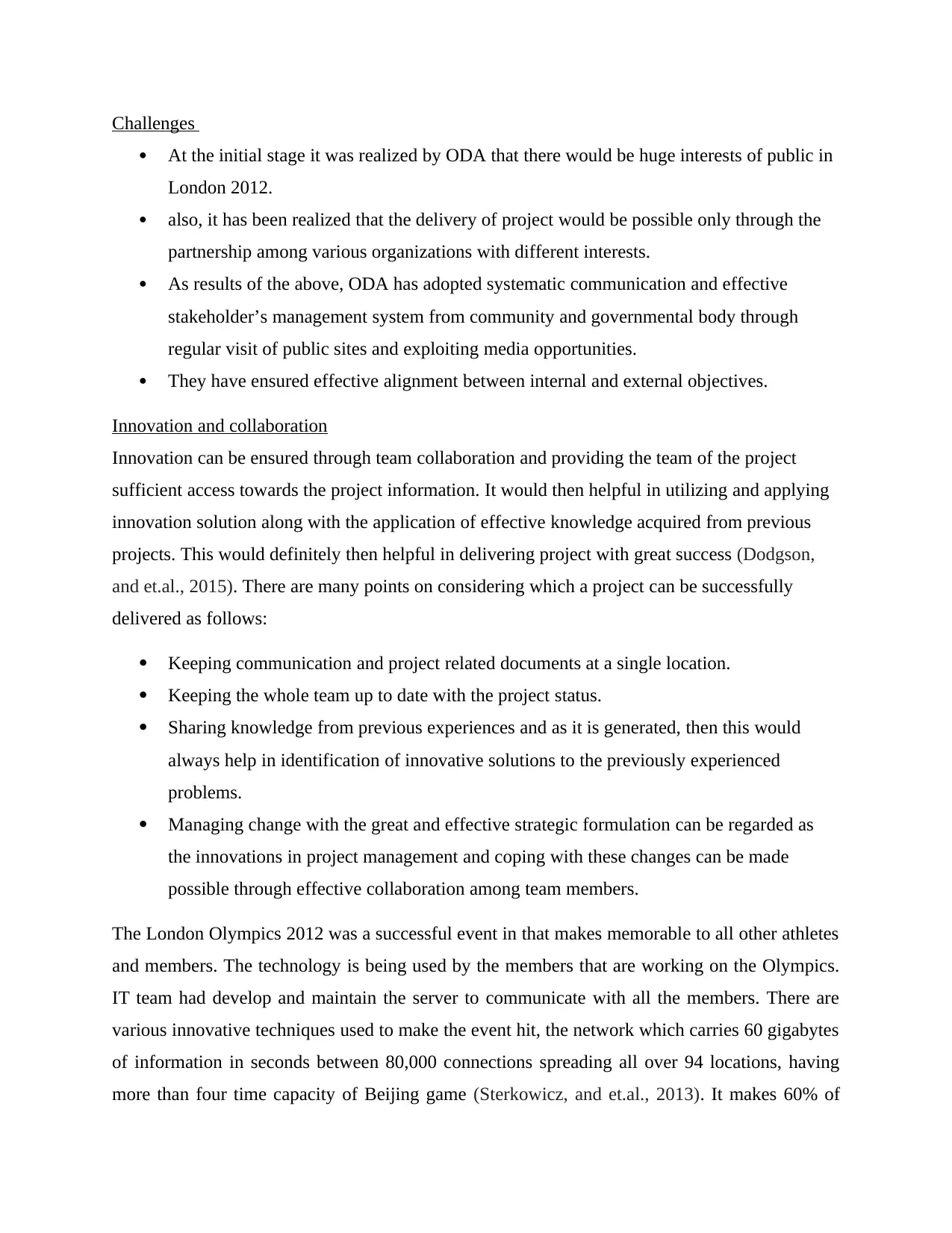
Challenges
At the initial stage it was realized by ODA that there would be huge interests of public in
London 2012.
also, it has been realized that the delivery of project would be possible only through the
partnership among various organizations with different interests.
As results of the above, ODA has adopted systematic communication and effective
stakeholder’s management system from community and governmental body through
regular visit of public sites and exploiting media opportunities.
They have ensured effective alignment between internal and external objectives.
Innovation and collaboration
Innovation can be ensured through team collaboration and providing the team of the project
sufficient access towards the project information. It would then helpful in utilizing and applying
innovation solution along with the application of effective knowledge acquired from previous
projects. This would definitely then helpful in delivering project with great success (Dodgson,
and et.al., 2015). There are many points on considering which a project can be successfully
delivered as follows:
Keeping communication and project related documents at a single location.
Keeping the whole team up to date with the project status.
Sharing knowledge from previous experiences and as it is generated, then this would
always help in identification of innovative solutions to the previously experienced
problems.
Managing change with the great and effective strategic formulation can be regarded as
the innovations in project management and coping with these changes can be made
possible through effective collaboration among team members.
The London Olympics 2012 was a successful event in that makes memorable to all other athletes
and members. The technology is being used by the members that are working on the Olympics.
IT team had develop and maintain the server to communicate with all the members. There are
various innovative techniques used to make the event hit, the network which carries 60 gigabytes
of information in seconds between 80,000 connections spreading all over 94 locations, having
more than four time capacity of Beijing game (Sterkowicz, and et.al., 2013). It makes 60% of
At the initial stage it was realized by ODA that there would be huge interests of public in
London 2012.
also, it has been realized that the delivery of project would be possible only through the
partnership among various organizations with different interests.
As results of the above, ODA has adopted systematic communication and effective
stakeholder’s management system from community and governmental body through
regular visit of public sites and exploiting media opportunities.
They have ensured effective alignment between internal and external objectives.
Innovation and collaboration
Innovation can be ensured through team collaboration and providing the team of the project
sufficient access towards the project information. It would then helpful in utilizing and applying
innovation solution along with the application of effective knowledge acquired from previous
projects. This would definitely then helpful in delivering project with great success (Dodgson,
and et.al., 2015). There are many points on considering which a project can be successfully
delivered as follows:
Keeping communication and project related documents at a single location.
Keeping the whole team up to date with the project status.
Sharing knowledge from previous experiences and as it is generated, then this would
always help in identification of innovative solutions to the previously experienced
problems.
Managing change with the great and effective strategic formulation can be regarded as
the innovations in project management and coping with these changes can be made
possible through effective collaboration among team members.
The London Olympics 2012 was a successful event in that makes memorable to all other athletes
and members. The technology is being used by the members that are working on the Olympics.
IT team had develop and maintain the server to communicate with all the members. There are
various innovative techniques used to make the event hit, the network which carries 60 gigabytes
of information in seconds between 80,000 connections spreading all over 94 locations, having
more than four time capacity of Beijing game (Sterkowicz, and et.al., 2013). It makes 60% of
⊘ This is a preview!⊘
Do you want full access?
Subscribe today to unlock all pages.

Trusted by 1+ million students worldwide
1 out of 17
Related Documents
Your All-in-One AI-Powered Toolkit for Academic Success.
+13062052269
info@desklib.com
Available 24*7 on WhatsApp / Email
![[object Object]](/_next/static/media/star-bottom.7253800d.svg)
Unlock your academic potential
Copyright © 2020–2025 A2Z Services. All Rights Reserved. Developed and managed by ZUCOL.





